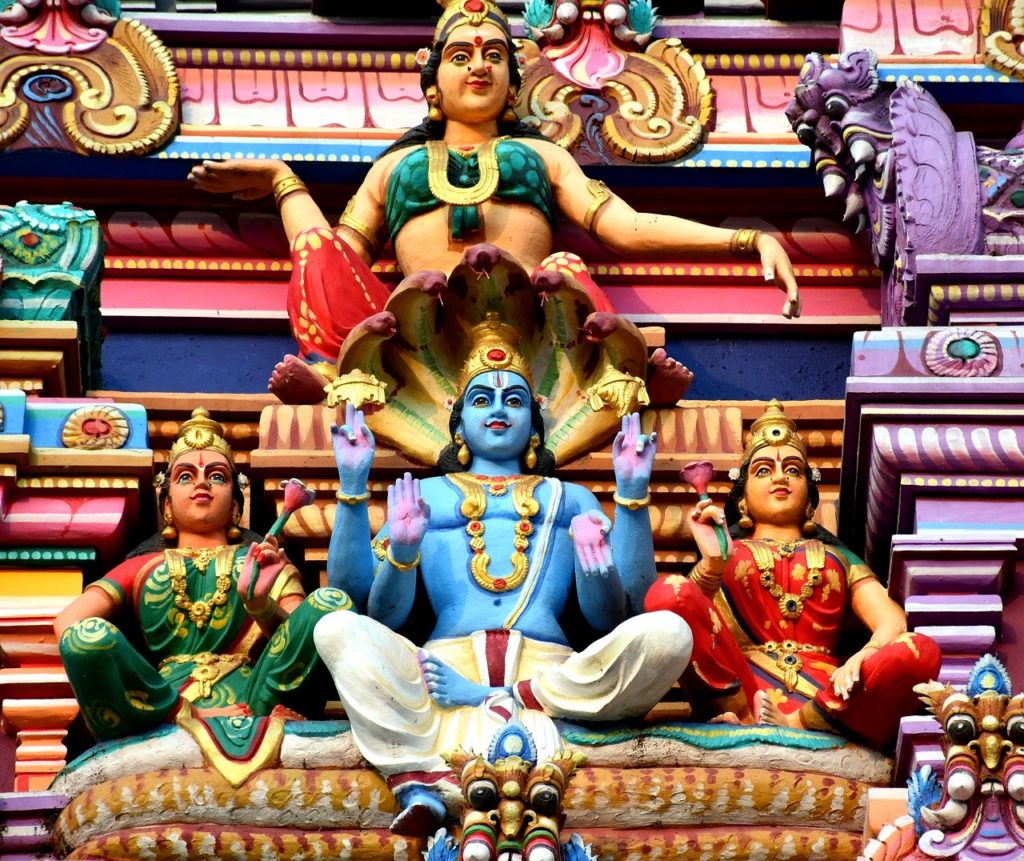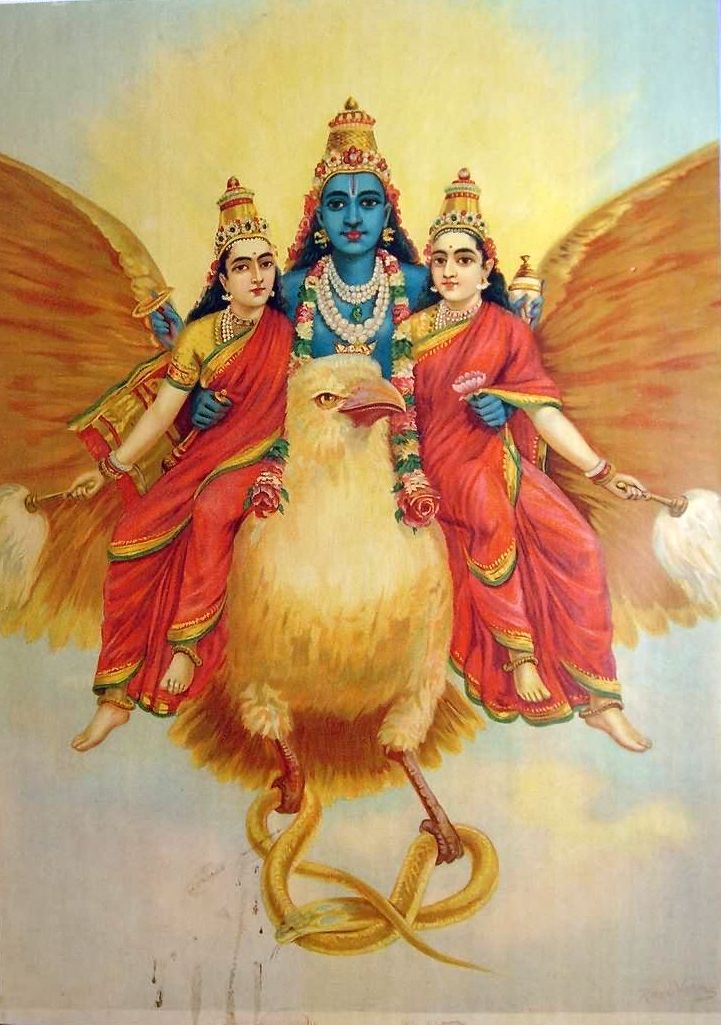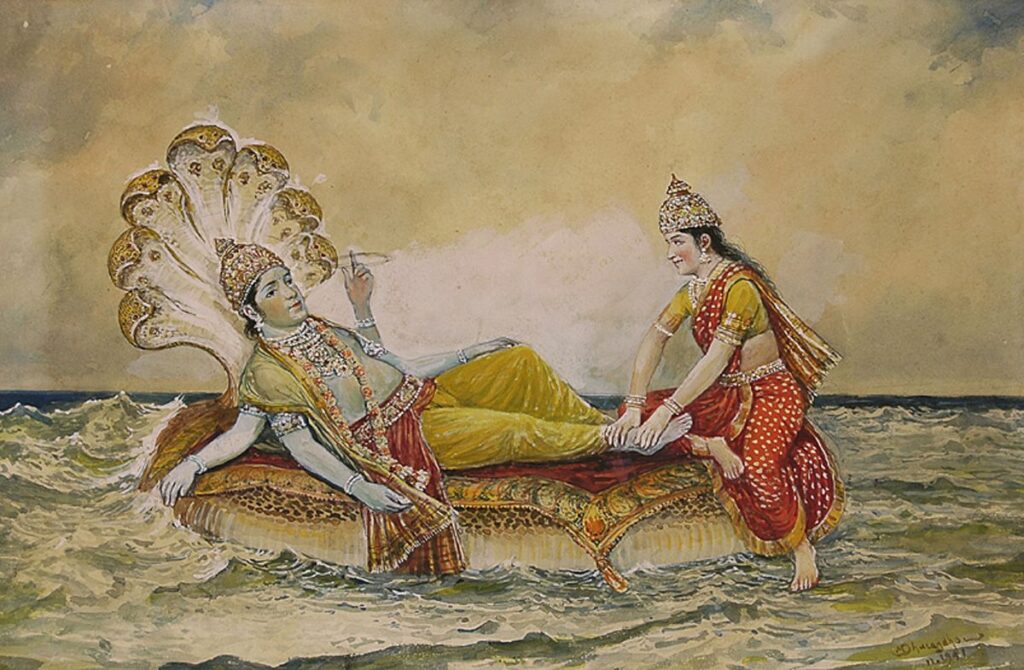
Lord Vishnu, a central and revered figure in Hinduism, holds a significant position as one-third of the divine Trimurti, alongside Brahma and Shiva. His divine responsibility revolves around the crucial role of sustaining and preserving the universe. Adored by countless devotees, Vishnu stands as one of the primary deities in the vast pantheon of Hindu gods. Vaikuntha loka, the celestial abode of Vishnu, is a realm of sublime spiritual existence. Within its ethereal confines, he is known by the name Narayana. Descriptions of Vishnu from the sacred Srimad Bhagavatam paint an awe-inspiring picture of an extraordinary male form, captivatingly beautiful, adorned with resplendent, spiritual jewels, and adorned with four hands, each holding symbolic items—a club, a conch shell, a chakra (discus), and a lotus flower. As part of the Trimurti, Vishnu presides over sattva-guna, the quality of goodness, which embodies harmony, purity, and enlightenment. As the cosmic maintainer, he ensures the cosmic balance and upholds the order of the universe. His devotees worship him with profound devotion, recognizing his supreme status and benevolent influence.
Appearance of Vishnu
Deep within the sacred domain of Vaikuntha loka lies Krishnaloka, the supreme planet of the spiritual realm, an exalted abode exclusively reserved for Lord Krishna. This divine realm, adorned with celestial splendor, unfolds into three enchanting segments: Dwarka, Mathura, and Goloka, each radiating an enchanting allure of its own.

Within the resplendent boundaries of Krishnaloka, the Supreme Lord reveals Himself in four magnificent plenary expansions: Krishna, Balarama, Pradyumna, and Aniruddha. Among these divine emanations, Balarama, gracefully residing in Krishnaloka, represents the pristine Sankarshana, the original source of Maha-Sankarshana dwelling in the ethereal Vaikuntha planets. As the celestial maintainer, Maha-Sankarshana diligently upholds the spiritual sky and oversees the harmonious functioning of the celestial realms.
It is from the boundless reservoir of Maha-Sankarshana that the wondrous myriad of Lord Vishnu’s forms find their genesis. When the Supreme Personality of Godhead, Lord Krishna, desires to fashion the material world, He effortlessly expands Himself into three distinct Vishnu forms to accomplish this divine task.
Three Principal forms of Vishnu
Notably, Maha-Vishnu, an expansion of Sankarshana, lies reclining on the causal ocean and serves as the ultimate source of all universes. Garbhodakasayi Vishnu, in turn, emanates from Maha Vishnu and enters each universe to create its first living being, Brahma. This cosmic process unfolds within every universe’s inception. Furthermore, Garbhodakasayi Vishnu further extends into Ksirodakasayi Vishnu, who resides in the heart of every living entity as the Supersoul, orchestrating the intricate workings of creation.
Maha Vishnu
Maha Vishnu is the Purusha avatar who originates from Narayana, the Lord of Vaikuntha. Maha Vishnu is the source of the vast expanse of spiritual water known as the Causal ocean (Karana sagar). This is why the causal ocean is also known as ‘Sankarsanatmaka’ as it is created from the body of Sankarsana Maha-Vishnu. Maha Vishnu lies on the causal ocean resting upon the bed of Ananta Sesha. As He rests on the causal ocean or ‘Karana Sagar’, Maha Vishnu is sometimes also referred to as ‘Karanarnava-sayi Vishnu’. He glances at material nature (Prakriti), thus impregnating her with the seeds of the material universes and the spiritual sparks who populate those universes. Lord Maha-Vishnu then expands Himself into innumerable Garbodakasayi Vishnus in all of these universes.
Garbhodakasayi Vishnu
Garbhodakasayi Vishnu lies within the water of each universe and from His navel sprouts a lotus stem on whose atop sits Brahma, the chief engineer of the universe. The stem of this lotus is the resting place of the multitude of planets. When Garbhodakasayi Vishnu first enters a universe, he finds it dark and empty, with no place to reside. He first creates the universal water from the perspiration of His body, which fills half of the universe. He makes His own residence in these waters and thereafter manifests the planetary systems, in the other half of the universe. Within these universal waters, He manifests Vaikuntha, His own abode, and rests on it upon the bed of Ananta Sesha.
Ksirodakasayi Vishnu
Ksirodakasayi Vishnu, the Lord of the ocean of milk, manifests within the heart of every living being in a suitable size. In the case of human beings, His size is that of one pradesa (distance between the tips of a person’s extended thumb and index finger). Ksirodakasayi Visnu is commonly referred to as the Supersoul. Within the ocean of milk, there exists the island of Svetadvipa which is the abode of Ksirodakasayi Vishnu. Unable to find Him, the demigods, go to the shore of the milk ocean and offer prayers unto Him. Ksirodakasayi Vishnu descends to preserve the material world and vanquish principles of irreligion, millennium after millennium. Ksirodakasayi Vishnu is counted both among Purusha and Guna avatars of the Supreme Lord.
Symbols of Vishnu
Vishnu, the illustrious deity, is renowned for his striking blue complexion, which carries deep symbolic significance. Some view the sky-blue color as a representation of his all-pervading and omnipresent nature, while others consider it his inherent and ontological hue.

In the sacred space of his divine manifestation, Vishnu gracefully wields four essential symbols within his four arms. The club and discus serve as potent weapons, wielded against those who transgress the righteous path of dharma and defy the laws of nature. The discus, adorned with a thousand spokes, symbolizes the relentless wheel of time, known as the “kala-chakra.” On the other hand, the lotus and conch-shell hold a different purpose, bringing joy and pleasure to the hearts of the Lord’s devoted followers.
At his side, Vishnu’s beloved consort, Lakshmi, the goddess of fortune, stands as a symbol of prosperity and auspiciousness. A mark known as the Srivatsa, adorns his chest. This distinctive mark is a charming curl of hair gently resting on his right chest, its color reminiscent of the fragrant jasmine. Thus, Vishnu is often referred to as “Srivatsankita,” the one graced with the sign of Srivatsa. In addition to the Srivatsa, Vishnu also bears the imprint of sage Bhrigu’s feet upon his chest.
As he traverses the realms of existence, Vishnu rides upon the majestic eagle, Garuda, which serves as his sacred carrier. Additionally, in a captivating display of cosmic symbolism, he reclines on the magnificent, many-headed serpent, Ananta-shesha, as though embracing the vast expanse of creation.
When does Lord Vishnu incarnate in this world ?
The below is stated in Bhagavad Gita regarding Lord Vishnu and his incarnations.
paritranaya sadhunam
vinasaya ca duskrtam
dharma-samsthapanarthaya
sambhavami yuge yuge
(Bhagavad Gita 4.8)
–
Millennium after millennium, I (Krishna) incarnate myself to deliver the pious, annihilate the miscreants, and reestablish the principles of dharma (religion).
Dasavatara – Ten incarnations of Vishnu
The Bhagavat Purana provides a list of twenty-two incarnations of Vishnu, but the ten primary incarnations, known as the Dashavatar, are as follows:
- Matsya – The fish incarnation of the Supreme Lord who towed the boat carrying seeds of every form of life and secured it to a peak in the Himalayan range. In this way, the Lord ensured the continuity of life in this world, saving it from the waters of universal annihilation. Like Varaha deva, the Mastya avatar also appears twice in a day of Brahma. In His first incarnation, he kills the demon Hayagriva (who steals the Vedas from Brahma) and rescues the Vedas. In His second avatar, He protects life on this world from the universal waters.
- Kurma – The tortoise incarnation of the Supreme Lord, whose shell served as a pivot for the Mandara hill, that was used as a churning rod by the demigods (devas) and the demons (asuras) during samudra manthan (churning of the milk ocean). Kurma avatar also perpetually holds up the earth and maintains it in its position in the universe.
- Varaha – Boar incarnation of the Supreme Lord who lifted earth from the nether regions of the universe, after killing the demon Hiranyaksha with His tusks. Hiranyaksha was responsible for drowning the earth in the great ocean of the universe. Varaha avatar appears twice in a day of Brahma. He first appears during the reign of Svayambhuva Manu where He lifts the earth from the lower regions of the universe. He appears again during Chaksusa Manu and this time while lifting the earth, He also kills the demon Hiranyaksha.
- Narasimha – Lord Narasimhadeva appeared from a pillar to protect His devotee Prahlada and vanquish the demon Hiranyakashipu, Prahlada’s father, who was trying to kill his own son. Lord Narasimha deva appeared in the sixth Manvantara, which happened before the churning of the milk ocean. This avatar has many vilasa expansions like Lakshmi Narasimha, Ugra Narasimha and others, each possessing different bodily complexions and activities.
- Vamana – The dwarf Brahmana incarnation of the Lord who tricked Bali maharaj by asking for three steps of land, and thereby denying him of all his material possessions. The King ultimately dedicated his own body to fulfill the measurement of the Lord’s third step. Vamana deva was won over by Bali Maharaj and hence the Lord served as the King’s doorkeeper.
- Bhargava Parasurama – The Supreme Lord appeared as the brahmana named Parasurama, who was the son of Renuka and Jamadagni. He was a descendant of Bhrigu muni. He vanquished all the Kings, encircling the world twenty one times. He was angry with them as they had deviated from religious principles.
- Ramachandra – Lord Rama appeared in Treta Yuga. He was the son of Dasaratha and Kausalya. He killed the demon Ravana.
- Balarama – Balarama is the brother of Lord Krishna. He is the first expansion of the Supreme Lord. Lord Balarama first entered the womb of Devaki and was then conveyed to the womb of Rohini. Thus He literally has two mothers. Balarama expands as Sankarsana who also manifests Himself as the holder of the earth and also the bed of Lord Vishnu.
- Buddha – Son of Anjana, Buddha deludes the atheists, by speaking on sub-religious principles.
- Kalki – Kalki avatar appears at the conjunction of Kali and Satya yugas. By this time, the rulers of earth degenerate into plunderers. Kalki avatar makes His appearance to annihilate the miscreants and re-establish the postulates of eternal religion. He appears as the son of Vishnuyasha, an eminent brahmana of a village named Shambhala.
Krishna, being the source of Vishnu, is not included in the list of the ten avatars (incarnations) of Vishnu. This fact has been confirmed in various Vedic scriptures. It is explained that Krishna is the source of all other incarnations of the Supreme, although there is no distinction between Vishnu and Krishna, as they are the same person expressing different moods. Krishna is like the original candle that illuminates all other candles, being the original Supreme Person from whom others manifest. Despite the fact that everything emanates from the Supreme Being, He remains aloof from it all, engaging in His eternal pleasure pastimes with His devotees in the spiritual realm. Thus, in the process of creating the material worlds, Krishna expands Himself into various plenary forms.

Ete camsa kalah pumsah krsnas tu bhagavan svayam
Indrari vyakulam lokam mrdayanti yuge yuge
(Srimad Bhagavatam 1.3.28)
–
All these incarnations are either plenary portions or portions of plenary portions of the Supreme Lord, but Lord Krishna is the original Supreme Personality of Godhead. All of His incarnations appear whenever there is a disturbance created by atheists. These incarnations appear to protect the theists.
This is also confirmed by Lord Brahma in his prayers :
Isvarah paramah krishna sac cid ananda vigrahah
Anadir adir govindah sarva karana karanam
(Brahma Samhita 5.1)
–
Krishna, who is also known as Govinda, is the Supreme Personality of Godhead. He has a transcendental form of eternal bliss and knowledge. He is the origin of all and the prime cause of all causes.
Vishwaroop
Krishna revealed His Vishwaroop or Universal form to Arjuna in the battlefield of Kurukshetra. In the awe-inspiring Vishwaroop, Arjuna beheld an extraordinary vision of Lord Vishnu’s universal form, a spectacle beyond human comprehension. This divine manifestation revealed countless mouths, eyes, and wondrous visions, each emanating celestial brilliance. Adorned with resplendent celestial ornaments and divine upraised weapons, Vishnu stood as the embodiment of cosmic majesty.
His divine attire comprised celestial garlands and garments, and a divine fragrance enveloped His entire form, enchanting all who beheld Him. The universe seemed to expand limitlessly within His majestic presence, and the radiance that emanated from Him was akin to the combined brilliance of innumerable suns dawning upon the sky.
Within this boundless expanse, Arjuna discerned the intricate interplay of countless universes, harmoniously unified in one awe-inspiring form. The great demigods, including Brahma and Lord Shiva, sages, and divine serpents resided within Him, offering obeisance to the Supreme Lord. His form stretched infinitely, adorned with a myriad of arms, bellies, mouths, and eyes, revealing the profound extent of His omnipotence.
Yet, amidst this resplendent effulgence, the universal form’s glare made it challenging to perceive every detail. Adorned with regal crowns, clubs, and discs, He appeared as a dazzling fire, radiating immeasurable luminosity, captivating and overwhelming all who gazed upon Him.
Arjuna, bewildered and humbled, bowed his head in reverence and began to offer prayers to the Supreme Lord, seeking to understand the nature of this universal form and its significance. He perceived the Supreme Lord as the eternal, inexhaustible source of all creation, the oldest and ultimate resting place of the entire cosmos.
The cosmic display included the sun and moon as His eyes, while His divine presence expanded throughout the sky, the planets, and all the spaces between, engendering awe and perturbation among the various planetary systems.
Witnessing the demigods and sages surrendering to Him, Arjuna witnessed the multitude of celestial beings, each in wonder at the divine display before them. However, amidst this awe-inspiring grandeur, fear crept into Arjuna’s heart, as he beheld the destructive power inherent in the universal form.
Seeking solace and understanding, Arjuna entreated the Lord to reveal His true identity and mission. In response, the Supreme Personality of Godhead revealed Himself as Time, the great destroyer of worlds, and declared His intent to annihilate all but the Pandavas in the imminent battle.